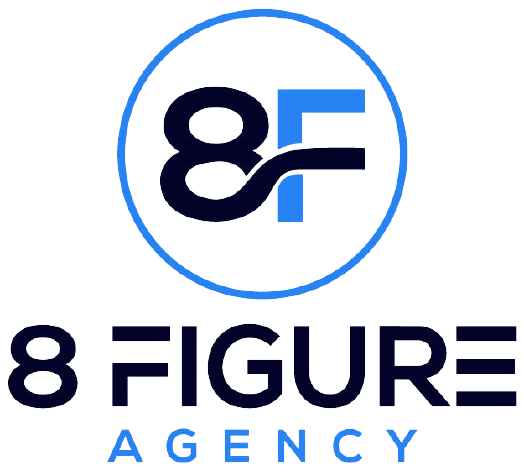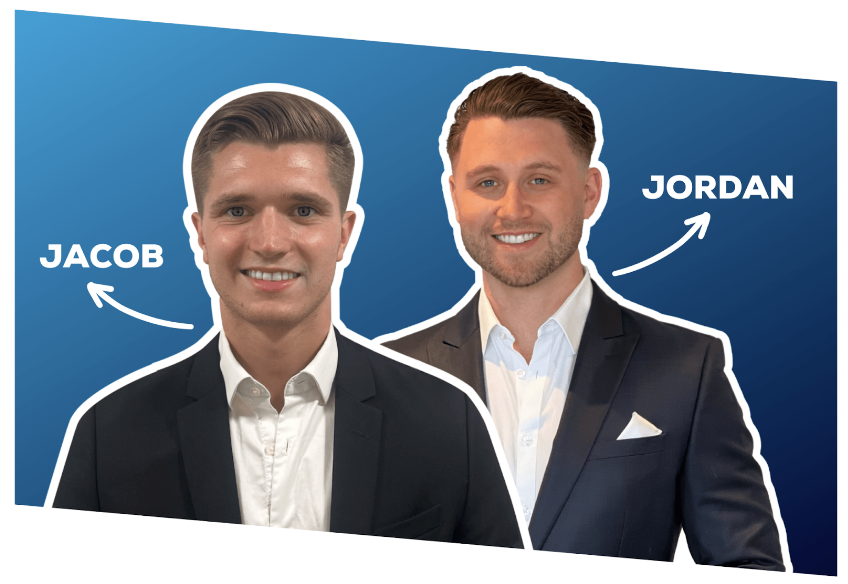A marketing agency scorecard is a performance metrics tool specifically designed for agencies to track and measure their effectiveness in delivering results for clients. It goes beyond traditional metrics like impressions and clicks, focusing on key performance indicators (KPIs) that align with client goals and business objectives. This boils down to using KPIs that measure only what matters to your agency.
In this guide, we will break down what matters and show you how to leverage our proprietary 8 Figure Agency (8FA) scorecard and performance metric for your marketing agency. We have used our expertise to help over 300 clients achieve 8 figures and created over 3000 jobs. Find out how we can do the same for your marketing agency.
Book A Free Consultation Today!
Importance of Measuring Marketing Agency Performance Metrics
Measuring marketing agency performance is crucial for showcasing ROI, optimizing campaigns with data-driven insights, fostering transparency for stronger client relationships, and refining internal processes for enhanced efficiency. It enables agencies to showcase their Return on Investment (ROI) and highlight their pivotal role in contributing to client success, thereby justifying fees and establishing trust.
By leveraging data-driven insights marketing agencies can facilitate the optimization of campaigns by refining strategies, allocating resources effectively, and enhancing overall campaign performance. Lastly, by identifying areas for improvement, agencies can refine their internal processes, subsequently increasing efficiency and elevating overall operational effectiveness.
How 8FA’s Scorecard Differentiates From EOS
While both 8FA’s scorecard and EOS (Entrepreneurial Operating System) focus on goal setting and accountability, they differ in their specific approaches:
- Focus: 8FA’s scorecard is marketing-specific, focusing on KPIs directly tied to marketing campaign performance. EOS, on the other hand, has a broader organizational focus, encompassing various aspects of the business.
- Metrics: 8FA utilizes marketing-specific metrics like lead generation, conversion rates, and customer lifetime value. EOS uses various metrics related to various business areas like revenue, profit, and employee engagement.
- Methodology: 8FA’s scorecard follows a data-driven approach, relying heavily on quantitative data to track progress and measure success. EOS emphasizes qualitative aspects like company culture, communication, and accountability.
The 8FA Scorecard: A New Standard in Agency Metrics
By focusing on these key performance indicators, the 8FA scorecard provides a comprehensive framework for evaluating marketing agency performance. It moves beyond traditional vanity metrics and emphasizes data-driven insights that track actual impact and value delivered to clients.
Client Satisfaction
The client satisfaction metrics go beyond conventional measures, evaluating an agency’s ability to exceed expectations consistently. Utilizing methods like Net Promoter Score, client surveys, and feedback mechanisms, it gauges loyalty and gathers qualitative and quantitative data on satisfaction. Monitoring meeting adherence and goal achievement provides insight into the agency’s success in meeting established objectives. These approaches offer a nuanced evaluation of the agency’s performance in surpassing client expectations.
Return on Investment (ROI)
ROI is a pivotal marketing evaluation metric. It assesses financial returns from agency-executed marketing campaigns. It tracks direct revenue, considers Customer Acquisition Cost (CAC) for new customers, and analyzes Cost per Lead (CPL) for qualified leads. Collectively, these metrics offer a comprehensive evaluation of campaign efficacy, revealing the agency’s impact on revenue and customer acquisition.
Lead Generation Effectiveness
Lead Generation Effectiveness gauges the agency’s ability to attract and qualify potential customers. It involves tracking lead volume and quality, monitoring conversion rates, and assessing Cost per Qualified Lead (CPL). These metrics collectively evaluate the agency’s impact on generating and converting leads, crucial for supporting the client’s business objectives.
Brand Awareness Impact
Brand Awareness Impact assesses the agency’s effectiveness in raising brand awareness. It includes tracking social media metrics, analyzing website traffic, and employing brand sentiment analysis. These measures provide a holistic view of the agency’s impact on brand perception, encompassing social media influence, online visibility, and overall sentiment.
Designing a Customized Scorecard
Just as most tasks to boost performance, there is no cookie-cutter process. Designing a scorecard for your marketing agency is no different. Designing a customized scorecard is an iterative process. Start with a basic framework, track progress, analyze data, and refine your metrics and targets over time. This ensures your scorecard remains relevant and adaptable to your evolving business needs and goals. Here’s how to design a customized scorecard by tailoring the metrics to your business goals.
Tailoring Metrics to Business Goals
The foundation of a customized scorecard lies in aligning your chosen metrics with your specific business goals. This crucial step ensures that the scorecard serves as a meaningful roadmap for achieving desired outcomes. Consider these steps:
- Identify key business goals: Define your short-term and long-term objectives, encompassing areas like growth, profitability, brand awareness, or client satisfaction.
- Map goals to relevant metrics: For each goal, choose suitable metrics that accurately track progress and measure success. For example, if your goal is increased website traffic, relevant metrics could be unique visitors, session time, or bounce rate.
- Prioritize metrics: Not all performance metrics carry equal weight. Prioritize metrics based on their impact on achieving key goals. This helps focus resources and avoid data overload.
Balancing Short-term and Long-term Objectives
A well-designed scorecard strikes a balance between tracking immediate progress and monitoring long-term performance. Here’s how you can achieve this balance:
- Include a mix of leading and lagging indicators: Leading indicators, like social media engagement, predict future performance, while lagging indicators, like revenue or customer retention, reflect past results. This combination provides a holistic view of progress.
- Set realistic targets: Establish achievable but challenging targets for each metric, considering both short-term campaigns and long-term strategic goals.
- Monitor trends and adjust: Regularly analyze metric trends and adjust your scorecard as needed. Short-term campaigns may require more frequent monitoring, while long-term goals may need less regular updates.
A successful marketing agency uses a series of replicable actions essential for growth. At 8F, our objective is to assist you in optimizing your operations using our performance metrics that ensure consistent execution from your team. If achieving streamlined operations is a priority that has posed challenges, it may be beneficial to initiate a conversation.
Book A Free Consultation Today!
Measuring Client Communication and Collaboration
Maintaining effective communication and collaboration with clients is vital for any agency’s success. But how do you quantify these intangible interactions and assess their impact on your relationships?
Frequency and Quality of Communication
Tracking interaction numbers, response times, and your client’s preferences for communication channels will help to refine the evaluation of frequency. However, the quality assessment includes clarity, timeliness, and relevance surveys. Evaluating active listening and responsiveness to client concerns ensures a mutual understanding. This dual assessment offers a comprehensive view of the agency’s communication dynamics which is vital for successful client collaboration.
Collaboration on Strategy and Campaigns
Collaboration on Strategy and Campaigns is evaluated in two phases: Joint planning and goal setting, and Campaign execution and optimization. The initial phase measures client involvement in defining objectives, strategies, and KPIs. It tracks collaborative sessions, feedback exchange, and mutual understanding of plans. In the execution phase, assessment includes how effectively clients share data, insights, and resources, along with collaborative problem-solving.
It’s important to note that transparency in sharing performance data and making adjustments ensures a comprehensive evaluation of agency-client collaboration throughout the campaign lifecycle.
Analyzing Data and Analytics Capabilities
As data continues to dominate today’s digital world, the ability to effectively analyze data and leverage analytics capabilities sets marketing agencies apart.
Utilizing Data for Informed Decision-making
Strategically leveraging data empowers agencies to make informed decisions. Accurate data analysis reveals trends, patterns, and areas for improvement in campaign performance. On the other hand, predictive analytics anticipates future trends, enabling proactive strategy adaptation. Data drives personalized marketing, enhancing engagement and conversion rates, so use it. Resource allocation can be optimized through effective channel and campaign identification, thus maximizing ROI. Overall, data utilization enhances agency decision-making, fostering a proactive and personalized approach across operations.
Analytics Tools and Technologies
The landscape of analytics tools and technologies is vast and constantly evolving. Choosing the right ones depends on your specific needs and budget. Here are some options to consider:
- Web analytics platforms: Tools like Google Analytics, Adobe Analytics, and Clicky provide insights into website traffic, user behavior, and campaign performance.
- Social media analytics tools: Platforms like Sprout Social and Hootsuite offer data on social media engagement, audience demographics, and campaign reach.
- Customer relationship management (CRM) systems: Tools like Salesforce and HubSpot store customer data, track interactions, and provide insights into customer behavior and preferences.
- Business intelligence (BI) platforms: Solutions like Tableau and Power BI help you visualize data, create dashboards, and identify trends across different data sources.
- Marketing automation platforms: Tools like Marketo and Pardot automate marketing tasks and provide data on campaign performance and lead generation.
Tracking Campaign Performance Metrics

Effectively tracking campaign performance is the lifeblood of any successful marketing agency. It allows you to understand what’s working, and what’s not, and make data-driven decisions to optimize your strategies for maximum impact.
Evaluating the Success of Individual Campaigns
The success of any campaign hinges on aligning your chosen metrics with your defined goals. Here’s how to evaluate performance effectively:
- Identify relevant KPIs: Align key performance indicators (KPIs) with your campaign objectives. For brand awareness campaigns, you might track impressions and reach, while lead generation campaigns focus on leads generated and conversion rates.
- Monitor data in real-time: Utilize analytics tools to track campaign performance metrics in real time. This allows for prompt identification of any unexpected drops or surges in performance.
- Compare to benchmarks: Benchmark your campaign performance against industry standards or set internal targets to assess success. Remember, benchmarks and targets should be realistic and aligned with your specific campaign goals.
- Go beyond the numbers: While quantitative data is crucial, incorporate qualitative aspects like customer feedback, social media engagement, and brand sentiment analysis to gain a holistic understanding of campaign impact
Adjusting Strategies Based on Performance Data
Performance tracking insights can drive your strategy optimization and maximize your ROI. A/B testing identifies resonant elements which then paves the way for continuous refinement. Budget allocation can also be optimized based on performance data, focusing on high ROI channels while analyzing audience demographics and behavior can refine your targeting parameters. Communicating learnings to clients enhances transparency and trust. Data-driven discussions foster stronger partnerships and improve future campaign results.
Budget Adherence and Resource Allocation
Managing your agency’s budget and allocating resources effectively contributes to the financial health and sustainability of your marketing agency.
Monitoring Budget Utilization
Knowing where your money is going is essential for maintaining control and staying on track. You can start by developing detailed budgets for campaigns and breaking down costs. Real-time expense tracking and variance analysis can identify overspending or savings areas. Regular communication with stakeholders and team collaboration ensures responsible spending, creating a structured approach for monitoring and optimizing budget utilization.
Allocating Resources for Optimal Results
Allocating resources strategically can maximize your agency’s ROI and achieve campaign goals. Try to prioritize alignment with objectives, investing in high-potential strategies and channels to yield desired results. By taking into consideration your team’s capacity and skills you can avoid overstretching resources, then you can use technology for workflow efficiency and task prioritization. Flexibility is key; adjusting allocations based on performance and market changes to always ready to re-evaluate and enhance overall effectiveness.
A shared factor among thriving businesses is their grasp of internal data. Without the establishment of effective tracking and reporting systems, achieving a 7 or 8-figure status will prove challenging for your business. 8 Figure Agency specializes in Data and Reporting as one of our core principles for growing marketing agencies to 8 figures. Need More information about our process?
Book A Free Consultation Today!
Team Competency and Skill Development
Investing in your team’s competency and skill development is an investment in your agency’s future success. A skilled and motivated team is adaptable, efficient, and capable of delivering exceptional results for clients. Let’s dive into two key aspects of building a strong learning culture.
Assessing Team Expertise
Understanding your team’s current strengths and weaknesses is the first step to developing an effective skill development plan. Here are some ways to assess expertise:
- Formal evaluations: Conduct regular performance reviews with clear criteria and feedback mechanisms.
- Self-assessment tools: Utilize personality and skills assessments to gain insights into individual strengths and preferences.
- Skills gap analysis: Compare your team’s current skills with the requirements of current and future projects and identify areas for improvement.
- Project performance analysis: Regularly evaluate the effectiveness of project execution and identify areas where skill development could optimize performance.
Strategies for Continuous Skill Enhancement
Once you have a clear understanding of your team’s needs, you can implement a variety of strategies to foster continuous skill development:
- Formal training programs: Offer internal or external training programs on relevant topics like marketing automation, social media management, data analysis, and project management.
- Mentorship programs: Pair experienced team members with junior employees to facilitate knowledge transfer and skill development.
- Cross-functional collaboration: Encourage collaboration between different teams to expose individuals to new skills and perspectives.
- Project-based learning: Assign projects that challenge team members to learn new skills and apply them in real-world scenarios.
- Self-directed learning: Provide resources and support for individual learning through online courses, conferences, and professional development books.
Adapting to Market Trends
Staying ahead of the curve is essential for any marketing agency’s success. Adapting to market trends allows you to remain relevant, deliver innovative solutions, and attract new clients. Not sure where to get started, 8 Figure Agency has prepared a guide to help you understand how consulting with us can benefit you.
Staying Current with Industry Trends
Keeping your finger on the pulse of the industry can help you understand where the market is heading and prepare your agency for future opportunities. This can be achieved through engaging with publications, newsletters, blogs, and conferences. You can also use social media to follow leaders, influencers, and competitors. Networking with professionals works for knowledge sharing while conducting internal research provides market-specific trends. This ensures your agency is well-informed and poised for evolving opportunities.
Flexibility in Adapting to Market Changes
Once you’ve identified relevant trends, the next step is to be flexible and adapt your agency’s offerings and approach accordingly. Start by encouraging experimentation and rapid prototyping and investing in ongoing training for team reskilling. Try to embrace Agile project management for flexibility while diversifying services to address emerging trends. Adopt technologies for enhanced efficiency and to stay dynamic and well-prepared for evolving market conditions.
Client Retention Strategies
By implementing strategies and focusing on nurturing long-term relationships, you can transform your agency into a client magnet, retaining valuable partnerships and securing sustained success in the competitive marketing landscape.
Building Long-term Client Relationships
Building long-term relationships fosters trust, loyalty, and consistent revenue for your agency. There are strategies for nurturing these relations for your mutual benefit.
- Proactive communication: Regularly touch base with clients, sharing industry insights, relevant news, and potential opportunities beyond their immediate campaigns.
- Exceeding expectations: Go the extra mile to deliver exceptional results and surprise clients with unexpected value additions.
- Transparency and open communication: Be transparent about campaign performance, challenges, and opportunities, fostering collaboration and trust.
- Investing in relationship-building: Dedicate time and resources to understanding client goals, perspectives, and internal dynamics.
- Celebrating successes together: Share credit for campaign wins and celebrate accomplishments with clients to solidify the collaborative spirit.
Addressing Client Concerns and Feedback
Demonstrating responsiveness and attentiveness to client concerns are essential for building trust and preventing churn. You can achieve this by:
- Active listening and empathy: Actively listen to client concerns, acknowledge their frustrations, and express genuine empathy.
- Prompt and transparent response: Address concerns promptly with clear explanations and proposed solutions. Don’t shy away from acknowledging mistakes and taking responsibility.
- Proactive feedback solicitation: Regularly request feedback through surveys, meetings, or informal conversations to identify and address potential issues before they escalate.
- Implementing feedback effectively: Show clients you value their input by implementing their feedback and demonstrating the positive impact it has on campaigns.
- Proactive problem-solving: Be proactive in anticipating potential challenges and presenting solutions before they arise.
Allow 8 Figure Agency to be your companion as we navigate through the steps together. Regardless of the current stage of growth or challenges your company is encountering, whether it’s agencies generating $20k/month or $2MM/month, a robust culture is integral to your future success. Seeking to enhance your company’s culture, acquiring and retaining new clients?
Book A Free Consultation Today!
Technology Integration for Efficiency
Marketing technologies and streamlined processes can transform your agency into a well-oiled machine. You’ll free up your team’s time for higher-value tasks, drive increased efficiency, and achieve remarkable results for your clients, propelling your agency toward sustained success in a technology-driven marketing landscape.
Adopting Marketing Technologies
Choose tools that complement strengths and address specific needs when adopting marketing technologies. Use marketing automation platforms for task automation, and CRM systems for centralized client data and seamless communication. You can utilize data analytics tools for valuable insights, optimizing strategies, and personalizing client experiences. You can also streamline workflows with project management software for effective collaboration, and leverage AI-powered content creation tools for efficient high-quality content production. This comprehensive approach enhances agency efficiency, effectiveness, and overall performance.
Streamlining Processes for Increased Efficiency
Once you have the right tools in place, it’s time to leverage their capabilities to transform your workflows. Start by Identifying and standardizing repetitive tasks, and exploring automation. Then integrate and centralize tools for unified data flow, eliminating manual transfers and investing in team training for technology utilization. You can measure technology’s impact on efficiency and ROI, to refine the processes as well as embrace flexible work models for productivity and well-being. This ensures efficient processes and adapts to evolving work dynamics, contributing to increased overall efficiency.
Agencies Leveraging the 8FA Scorecard
Discover how these agencies leveraged the 8 Figure Agency Scorecard to grow their marketing agency!
- Pneuma Media: Watch how David Riggs Built a Multi-Million Dollar Agency That Can Operate Without Needing Him In It
- 100 Celsius: Watch how 100 Celsius Added 53K MRR In 6 Months
- Alpenton Group: Watch how Brendan McKinnon Increased His Company Revenue By 40 Percent
Summary
Consistent evaluation is not a one-time exercise, but an ongoing journey of learning and growth. 8 Figure Agency has been using our Performance Metric Scorecard to help marketing agencies reach 8 figures in annualized revenue since 2021. By embracing our process, you’ll empower your agency to achieve its full potential and deliver outstanding results for your clients. Want to scale your marketing agency without working 14-hour days?
Get Started With An 8 Figure Agency Consultation Today!



















































